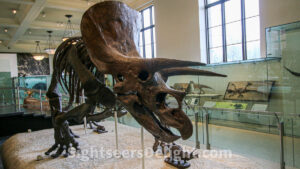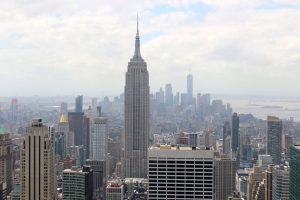Founded in 1869, the American Museum of Natural History in New York City is one of the world’s preeminent cultural institutions and features 45 permanent exhibition halls. The museum is home to the Theodore Roosevelt Memorial, New York State’s official memorial to its 33rd governor and the nation’s 26th president, and a tribute to Roosevelt’s enduring legacy of conservation. The museum’s five active research divisions and three cross-disciplinary centers support approximately 200 scientists, whose work draws on a world-class permanent collection of more than 34 million specimens and artifacts, as well as specialized collections for frozen tissue and genomic and astrophysical data, and one of the largest natural history libraries in the world.
10024
Battery Park is a 25-acre public park located at the southern tip of Manhattan Island. The area has been known as The Battery since the 17th century. The area was so-named because of artillery batteries that were positioned there in the city’s early years to protect the settlement.
The Brooklyn Bridge is perhaps the most famous bridge in the United States. The hybrid cable-stayed/suspension bridge spans the East River and was completed in 1883 to connect Manhattan and Brooklyn. The bridge was originally known as the New York and Brooklyn Bridge and the East River Bridge.
The 9.6-acre Bryant Park is unique in that it is part of the New York City Department of Parks and Recreation but privately managed. Located adjacent to the New York City Public Library, the history of the park dates to 1686, when Thomas Dongan, New York’s colonial governor, designated the area a public space. George Washington’s troops crossed the area while retreating from the Battle of Long Island in 1776, and in 1823, the site was designated a potter’s field (bodies were moved to Wards Island in 1840). The first park at this site, Reservoir Square, opened in 1847. The park was renamed in honor of New York Evening Post editor and abolitionist William Cullen Bryant in 1884.
10018
Castle Clinton, also known as Fort Clinton and previously Castle Garden, is a circular sandstone fort located in what is today Battery Park. The structure sits roughly two blocks west of where Fort Amsterdam was built in 1626. At the time, New York City was still named New Amsterdam. Construction on Castle Clinton started in 1808 and finished in 1811; it was built on a small artificial island just offshore. The structure was America’s first immigration station and predates Ellis Island. More than 8 million immigrants passed through Castle Clinton while entering the United States between 1855 and 1890.
10004
Central Park might be the most famous urban park in the world. City officials established the park in 1857 on 778 acres of city-owned land. The park was expanded to its current size of 843 acres in 1873. More than 40 million people visit the park every year. The U.S. Department of the Interior designated the park a National Historic Landmark in 1962.
What is Coney Island and how do you describe it in 100 or so words? It’s a neighborhood, an entertainment district and a popular tourist destination. Maybe more than anything, Coney Island is quintessentially New York City. It transformed into a seaside resort by the middle of the 19th century, and amusement parks followed a few years later. While Coney Island’s popularity waned following World War II, the area has experienced a resurgence in recent years, thanks in part to the opening of the MCU Park in 2001.
For millions of immigrants, Ellis Island was the first view of America. Today, it is a moving experience for anyone wanting to learn more about that era in U.S. history. The island, part of Statue of Liberty National Monument, sits in the shadow of the Statue of Liberty. Though quiet today, it’s amazing to think of what the Great Hall was like as new arrivals to the country passed through in search of a better life here.
The Empire State Building is arguably the most iconic representation of Gotham City. The 102-story-tall skyscraper was built in 1930-31 and opened on May 1, 1931. It was the tallest man-made structure in the world until 1954 and today is the second-tallest skyscraper in New York and the fifth-tallest completed in the country. The view from the observation deck is awesome, to say the least.
Flushing Meadows–Corona Park is the largest park in Queens and the fourth-largest public park in New York City. The 897-acre park was created for the 1939-40 New York World’s Fair, and it later hosted the 1964-65 New York World’s Fair. The park is perhaps best know for the New York State Pavilion and the Unisphere, the giant spherical stainless steel representation of the Earth.









